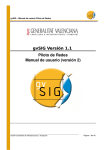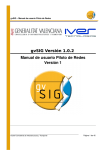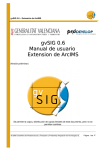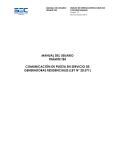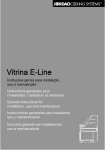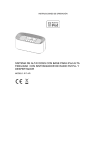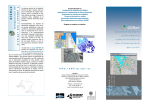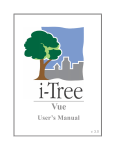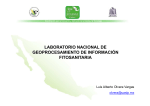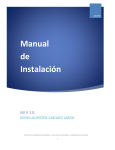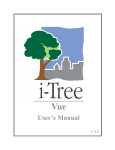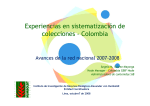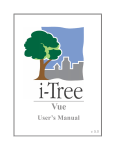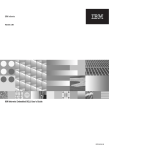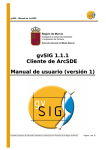Download Fe de erratas del Manual de usuario de gvSIG Versión 1.0
Transcript
gvSIG – Fe de erratas del manual de usuario Fe de erratas del Manual de usuario de gvSIG Versión 1.0 © 2006 Conselleria de Infraestructuras y Transporte e IVER Tecnologías de la Información S.A Página 1 de 28 gvSIG – Fe de erratas del manual de usuario IVER OFICINAS CENTRALES EN Conselleria de Infraestructuras y VALENCIA C/ Salamanca nº 5052 , 46005 Transporte C/ Blasco Ibáñez Nº 50 , 46010 VALENCIA VALENCIA Telf: 902 25 25 40 Fax: 96 316 27 16 EMail [email protected] www.iver.es EMail [email protected] Web del proyecto: http://www.gvsig.gva.es Todos los nombres propios de programas, sistemas operativos, equipo hardware etc.., que aparecen en este manual son marcas registradas de sus respectivas compañías u organizaciones. © 2006 Consellería de Infraestructuras y Transporte e IVER Tecnologías de la Información S.A Este documento se distribuye con la licencia GNU GPL2. noviembre 2006 Página 2 de 28 gvSIG – Fe de erratas del manual de usuario Índice de contenido Errores conocidos. Introducción...........................................................................................4 2 Proyectos y documentos propios..................................................................................5 2.4 Ventana de preferencias........................................................................................5 2.4.1 General...........................................................................................................5 2.4.4 Mapa (nuevo)..................................................................................................6 2.4.3 Vista................................................................................................................6 4 Vistas............................................................................................................................8 4.4 Añadir una capa a gvSIG.......................................................................................8 4.4.2 Añadir una capa a través de JDBC.................................................................8 4.4.3 Añadir una capa a través del protocolo WFS..................................................8 4.7 Propiedades de la capa........................................................................................12 4.7.1 Capa vectorial................................................................................................12 4.9 Configurar Localizador.........................................................................................15 4.20 Tratamiento de imágenes ráster.........................................................................16 4.20.6 Georreferenciación con cartografía base y puntos de control.....................16 5 Tablas..........................................................................................................................18 5.5 Cargar una tabla a partir de un origen de datos JDBC........................................18 6 Herramientas de edición..............................................................................................19 6.2 Edición gráfica......................................................................................................19 6.2.5 Propiedades de edición.................................................................................19 6.2.8 Órdenes de edición.......................................................................................19 6.3.4 Modificar la estructura de una tabla..............................................................20 7 Herramientas de Geoprocesamiento...........................................................................21 7.1 Introducción..........................................................................................................21 GNU GENERAL PUBLIC LICENSE...............................................................................22 © 2006 Conselleria de Infraestructuras y Transporte e IVER Tecnologías de la Información S.A Página 3 de 28 gvSIG – Fe de erratas del manual de usuario Errores conocidos. Introducción Debido a la necesidad de cerrar el manual para poder publicarlo junto con la 1.0 estable existen ciertas imágenes que no se corresponden con la interface que presenta la aplicación, lo que implica que el texto basado en ellas no es exacto. Se irán publicando distintas versiones de este documento intentando subsanar estas deficiencias. Para una mejor localización del texto modificado se ha intentado mantener la misma estructura del manual de usuario, de manera que la numeración del capítulo se correspondería con el lugar que debe ocupar en el manual de usuario. noviembre 2006 Página 4 de 28 gvSIG – Fe de erratas del manual de usuario 2 Proyectos y documentos propios 2.4 Ventana de preferencias 2.4.1 General 2.4.1.6 Configuración de pantalla (Nuevo) En el cuadro de texto”Resolución” puede indicar los puntos por pulgada de su pantalla. gvSIG le permite calcular la resolución exacta de su pantalla, para ello lleve a cabo el siguiente procedimiento: ● Mida con una regla sobre la pantalla la recta dibujada en el cuadro “Medida de prueba” ● Escriba en el cuadro de texto que viene a continuación la medida obtenida (en la imagen que sigue se ha insertado el valor 5,61) y las unidades en las que ha obtenido dicha medición (“Centímetros” en nuestro caso). ● A continuación pulse el botón “Calcula resolución” ● Automáticamente gvSIG le proporcionará un valor de puntos por pulgada de su resolución que aparecerá en el cuadro de texto correspondiente (el resultado en nuestro caso es 95 ppp) © 2006 Conselleria de Infraestructuras y Transporte e IVER Tecnologías de la Información S.A Página 5 de 28 gvSIG – Fe de erratas del manual de usuario 2.4.4 Mapa (nuevo) Desde esta sección de la ventana de preferencias puede personalizar como desea trabajar con sus documentos de mapas. Puede establecer los valores para el espaciado de la malla, tanto horizontal como vertical. Puede igualmente indicar si desea que se visualice la malla, activarla o desactivarla y activar o desactivar la regla, para ello simplemente pulse en los check según sus preferencias. Cuando haya terminado de configurar sus preferencias pulse el botón “Aceptar”. 2.4.3 Vista Puede establecer los valores que utilizará gvSIG cuando quiera realizar un zoom sobre una vista así como cambiar el color por defecto de la selección o el color de fondo de la vista. Desde esta ventana puede además establecer las unidades del mapa y de las mediciones que realice en gvSIG. noviembre 2006 Página 6 de 28 gvSIG – Fe de erratas del manual de usuario © 2006 Conselleria de Infraestructuras y Transporte e IVER Tecnologías de la Información S.A Página 7 de 28 gvSIG – Fe de erratas del manual de usuario 4 Vistas 4.4 Añadir una capa a gvSIG 4.4.2 Añadir una capa a través de JDBC En el manual se indica que se puede elegir entre varios driver de acceso a base de datos . De los drivers que se enumeran (Postgis, MySQL y HSQLDB), HSQLDB no está disponible en la versión 1.0 de gvSIG, sólo se puede elegir entre Postgis y MySQL 4.4.3 Añadir una capa a través del protocolo WFS 4.4.3.5 Selección de “Atributos” La pestaña “Atributos” permite seleccionar los campos (o atributos) de la capa seleccionada. Al cargar la capa, sólo se recuperarán los campos que han sido seleccionados. Para seleccionar los atributos active el check que aparece a la izquierda de los mismos. noviembre 2006 Página 8 de 28 gvSIG – Fe de erratas del manual de usuario 4.4.3.6 Pestaña “Opciones” En la pestaña “Opciones”, puede ver información relativa a la conexión. Los parámetros que hacen referencia a la conexión son: • Número máximo de features en el buffer, que es el número máximo de entidades que se pueden descargar. • Timeout, que representa el tiempo de espera más allá del cual se descarta la conexión por considerarse errónea. Si estos parámetros son muy bajos, puede que una petición correcta no obtenga respuesta. Otro parámetro importante es el SRS. (Sistema de coordenadas de referencia) que aunque de momento no se puede cambiar, está pensado que en un futuro si sea posible. En cualquier caso, gvSIG reproyectará la capa cargada al sistema de coordenadas que tenga la vista. © 2006 Conselleria de Infraestructuras y Transporte e IVER Tecnologías de la Información S.A Página 9 de 28 gvSIG – Fe de erratas del manual de usuario 4.4.3.7 Filtro (Nuevo) Desde esta pestaña puede realizar filtros sobre sus capas WFS. Para realizar un filtro sobre una capa WFS esta tiene que haber sido descargada previamente. Una vez cargada la capa WFS en el ToC pulse el botón secundario del ratón, en el manú contextual seleccione la opción “Propiedades del WFS” noviembre 2006 Página 10 de 28 gvSIG – Fe de erratas del manual de usuario En la ventana pulse sobre la pestaña “Filtros”. En el cuadro de texto “Campos” se muestran los atributos de la capa por los que puede © 2006 Conselleria de Infraestructuras y Transporte e IVER Tecnologías de la Información S.A Página 11 de 28 gvSIG – Fe de erratas del manual de usuario filtrar. Puede ver los valores del campo seleccionado pulsando sobre él. para confeccionar el filtro sobre la capa WFS haga doble click sobre el campo por el que desee filtrar, aparecerá en el área de texto inferior, a continuación pulse sobre el operador que desee aplicar y por último seleccione el valor en el área de texto “Valores” haciendo doble click sobre él. Pulse el cotón “Aceptar” cuando haya compuesto su filtro y éste se aplicará a la capa WFS. 4.7 Propiedades de la capa 4.7.1 Capa vectorial 4.7.1.1 Cambiar el color En el manual el funcionamiento de la pestaña HSB no está bien explicado. Puede fijar uno de los valores que que se utilizan para determinar el color, pulsando en el check que corresponda. Pulsando sobre el área del cuadrado podrá ir definiendo los valores para los noviembre 2006 Página 12 de 28 gvSIG – Fe de erratas del manual de usuario otros 2 parámetros, y desplazando la barra horizontal establecer el valor para el parámetro que tiene marcado en con el check. Cuando haya definido el color que desee pulse el botón “Aceptar”. 4.7.1.3 Propiedades En las capas shapes de tipo punto puede establecer en la pestaña “Simbología” con la opción “Símbolo único” el tipo de símbolo con el que desea que se visualice esa capa, así como el color y el tamaño del punto y si ese tamaño. © 2006 Conselleria de Infraestructuras y Transporte e IVER Tecnologías de la Información S.A Página 13 de 28 gvSIG – Fe de erratas del manual de usuario Pulse en el desplegable “Tipo de símbolo” y seleccione el símbolo que desee para la visualización de su capa. Seleccione el color y establezca el tamaño del símbolo que haya escogido. Pulse el botón “Aplicar” para ver una previsualización de la configuración que ha establecido. Pulse el botón “Aceptar” si desea que su configuración sea permanente. 4.7.1.4 Editor de leyendas 4.7.1.4.4 Etiquetado • Campo de altura de texto: Permite elegir el campo de la tabla de atributos de la capa que contiene los valores a utilizar como altura de las etiquetas. Cuando la altura se especifica en metros, deberá de ser un número entero, y que si no lo es se redondeará al entero menor más próximo. noviembre 2006 Página 14 de 28 gvSIG – Fe de erratas del manual de usuario 4.9 Configurar Localizador Falta indicar que se puede reproyectar la capa que se carga en el Localizador. Para ello cuando seleccione la capa que desee cargar en el Localizador pulse el botón situado al lado de “Proyección actual”. En la siguiente ventana seleccione el Datum, la Proyección y el Huso que desea que tenga la capa en el localizador y pulse el botón “Aceptar” para que los cambios se reflejen en la capa. © 2006 Conselleria de Infraestructuras y Transporte e IVER Tecnologías de la Información S.A Página 15 de 28 gvSIG – Fe de erratas del manual de usuario 4.20 Tratamiento de imágenes ráster 4.20.6 Georreferenciación con cartografía base y puntos de control Ha cambiado la interface de la ventana de georreferenciación de manera que donde ponía “longitud” y “Latitud” ahora pone X' Y'. Ventana georreferenciación antigua Ventana georreferenciación actual Debe tener en cuenta que los cuadros de texto “X” e “Y” pertenecen a la imagen a georreferenciar y que “X'” y “Y'” corresponden a la imagen georreferenciada. 4.20.6.5 Procesado El botón “Procesar” se ha quitado de la interface. Si pulsa el botón “Aceptar” estará aplicando el algoritmo que genera la georreferenciación para la imagen y la guarda en un fichero .rmf junto a ella. En las opciones puede marcar “Crear fichero de georreferenciación (worldfile)” para que pueda ser interpretado por otras aplicaciones. gvSIG utilizará el fichero generado por él mismo para la georreferenciación. noviembre 2006 Página 16 de 28 gvSIG – Fe de erratas del manual de usuario Ventana georreferenciar "Opciones" antigua Ventana georreferenciar "Opciones" actual 4.20.6.6 Restricciones Al cierre del manual la herramienta de georreferenciación “... sólo genera una georreferenciación básica calculando el origen y tamaño de pixel de la imagen, ni rota, ni ortorectifica ni reproyecta”, pero en la versión 1.0 gvSIG hace la transformación completa (traslación, rotación y escalado). © 2006 Conselleria de Infraestructuras y Transporte e IVER Tecnologías de la Información S.A Página 17 de 28 gvSIG – Fe de erratas del manual de usuario 5 Tablas 5.5 Cargar una tabla a partir de un origen de datos JDBC Se indica que se puede acceder a una base de datos Oracle directamente desde gvSIG, sin embargo, para acceder a una base de datos Oracle es necesario descargarse un driver específico disponible en la página web de Oracle. El archivo que hay que descargarse e instalar en gvSiG es ojdbc14.jar Puede acceder a la página desde la que descargarse el archivo desde la web de gvSIG http://www.gvsig.gva.es/index.php?id=1309&L=0%2F&K=1&L=0 o desde la propia web de Oracle pulsando el siguiente enlace http://www.oracle.com/technology/software/htdocs/distlic.html?url=http://www.oracle.com/t echnology/software/tech/java/sqlj_jdbc/htdocs/jdbc_10201.html Cuando haya descargado el archivo copielo a la carpeta bin\gvSIG\extensiones\com.iver.cit.gvsig\lib del directorio donde ha instalado gvSIG. noviembre 2006 Página 18 de 28 gvSIG – Fe de erratas del manual de usuario 6 Herramientas de edición 6.2 Edición gráfica 6.2.5 Propiedades de edición 6.2.5.3 Flatness Flatness podría ser definido como “Calidad de la superficie de un plano”. Este parámetro es como una tolerancia que se fija, para definir cuan curvo desea que sean las formas esféricas (círculos, elipses, arcos ...), cuanto mayor sea el número, menos tramos rectos se verán y menos forma esférica tendrá. 6.2.8 Órdenes de edición 6.2.8.8 Polígono interno El manual indica que para cerrar un polígono interno hay que pulsar la opción “End” del menú contextual, esa opción se ha cambiado de nombre y ahora se llama “Terminar” Definiendo su polígono interno, cuando ya no desee insertar más vértices, pulse el botón secundario del ratón y, en el menú contextual que aparece, seleccione “Terminar”. © 2006 Conselleria de Infraestructuras y Transporte e IVER Tecnologías de la Información S.A Página 19 de 28 gvSIG – Fe de erratas del manual de usuario 6.3 Edición alfanumérica 6.3.4 Modificar la estructura de una tabla Existe un error cuando se cambia la estructura de una tabla alojada en una base de datos postgresql superior a la versión 7.4. Para modificar la estructura debe utilizar un gestor de bases de datos apropiado. noviembre 2006 Página 20 de 28 gvSIG – Fe de erratas del manual de usuario 7 Herramientas de Geoprocesamiento 7.1 Introducción Al aplicar algunas de las herramientas de geoprocesamiento (por ejemplo RECORTE o CLIP) aparece una ventana desde la que se puede crear un índice espacial sobre la capa de entrada. Esto es un proceso interno, que se hace una única vez por cada capa por proyecto nuevo, que acelera los procesos de intersección espacial. Para crear un índice espacial para la capa de entrada y que este sea usado por los geoprocesos pulse el botón “Sí”. © 2006 Conselleria de Infraestructuras y Transporte e IVER Tecnologías de la Información S.A Página 21 de 28 gvSIG – Fe de erratas del manual de usuario GNU GENERAL PUBLIC LICENSE GNU GENERAL PUBLIC LICENSE Version 2, June 1991 Copyright (C) 1989, 1991 Free Software Foundation, Inc., 51 Franklin Street, Fifth Floor, Boston, MA 021101301 USA Everyone is permitted to copy and distribute verbatim copies of this license document, but changing it is not allowed. Preamble The licenses for most software are designed to take away your freedom to share and change it. By contrast, the GNU General Public License is intended to guarantee your freedom to share and change free softwareto make sure the software is free for all its users. This General Public License applies to most of the Free Software Foundation's software and to any other program whose authors commit to using it. (Some other Free Software Foundation software is covered by the GNU Lesser General Public License instead.) You can apply it to your programs, too. When we speak of free software, we are referring to freedom, not price. Our General Public Licenses are designed to make sure that you have the freedom to distribute copies of free software (and charge for this service if you wish), that you receive source code or can get it if you want it, that you can change the software or use pieces of it in new free programs; and that you know you can do these things. To protect your rights, we need to make restrictions that forbid anyone to deny you these rights or to ask you to surrender the rights. These restrictions translate to certain responsibilities for you if you distribute copies of the software, or if you modify it. For example, if you distribute copies of such a program, whether gratis or for a fee, you must give the recipients all the rights that you have. You must make sure that they, too, receive or can get the source code. And you must show them these terms so they know their rights. We protect your rights with two steps: (1) copyright the software, and (2) offer you this license which gives you legal permission to copy, distribute and/or modify the software. Also, for each author's protection and ours, we want to make certain that everyone understands that there is no warranty for this free software. If the software is modified by someone else and passed on, we want its recipients to know that what they have is not the original, so that any problems introduced by others will not reflect on the original authors' reputations. noviembre 2006 Página 22 de 28 gvSIG – Fe de erratas del manual de usuario Finally, any free program is threatened constantly by software patents. We wish to avoid the danger that redistributors of a free program will individually obtain patent licenses, in effect making the program proprietary. To prevent this, we have made it clear that any patent must be licensed for everyone's free use or not licensed at all. The precise terms and conditions for copying, distribution and modification follow. GNU GENERAL PUBLIC LICENSE TERMS AND CONDITIONS FOR COPYING, DISTRIBUTION AND MODIFICATION 0. This License applies to any program or other work which contains a notice placed by the copyright holder saying it may be distributed under the terms of this General Public License. The "Program", below, refers to any such program or work, and a "work based on the Program" means either the Program or any derivative work under copyright law: that is to say, a work containing the Program or a portion of it, either verbatim or with modifications and/or translated into another language. (Hereinafter, translation is included without limitation in the term "modification".) Each licensee is addressed as "you". Activities other than copying, distribution and modification are not covered by this License; they are outside its scope. The act of running the Program is not restricted, and the output from the Program is covered only if its contents constitute a work based on the Program (independent of having been made by running the Program). Whether that is true depends on what the Program does. 1. You may copy and distribute verbatim copies of the Program's source code as you receive it, in any medium, provided that you conspicuously and appropriately publish on each copy an appropriate copyright notice and disclaimer of warranty; keep intact all the notices that refer to this License and to the absence of any warranty; and give any other recipients of the Program a copy of this License along with the Program. You may charge a fee for the physical act of transferring a copy, and you may at your option offer warranty protection in exchange for a fee. 2. You may modify your copy or copies of the Program or any portion of it, thus forming a work based on the Program, and copy and distribute such modifications or work under the terms of Section 1 above, provided that you also meet all of these conditions: a) You must cause the modified files to carry prominent notices stating that you changed the files and the date of any change. b) You must cause any work that you distribute or publish, that in whole or in part contains or is derived from the Program or any part thereof, to be licensed as a whole at no charge to all third parties under the terms of this License. c) If the modified program normally reads commands interactively © 2006 Conselleria de Infraestructuras y Transporte e IVER Tecnologías de la Información S.A Página 23 de 28 gvSIG – Fe de erratas del manual de usuario when run, you must cause it, when started running for such interactive use in the most ordinary way, to print or display an announcement including an appropriate copyright notice and a notice that there is no warranty (or else, saying that you provide a warranty) and that users may redistribute the program under these conditions, and telling the user how to view a copy of this License. (Exception: if the Program itself is interactive but does not normally print such an announcement, your work based on the Program is not required to print an announcement.) These requirements apply to the modified work as a whole. If identifiable sections of that work are not derived from the Program, and can be reasonably considered independent and separate works in themselves, then this License, and its terms, do not apply to those sections when you distribute them as separate works. But when you distribute the same sections as part of a whole which is a work based on the Program, the distribution of the whole must be on the terms of this License, whose permissions for other licensees extend to the entire whole, and thus to each and every part regardless of who wrote it. Thus, it is not the intent of this section to claim rights or contest your rights to work written entirely by you; rather, the intent is to exercise the right to control the distribution of derivative or collective works based on the Program. In addition, mere aggregation of another work not based on the Program with the Program (or with a work based on the Program) on a volume of a storage or distribution medium does not bring the other work under the scope of this License. 3. You may copy and distribute the Program (or a work based on it, under Section 2) in object code or executable form under the terms of Sections 1 and 2 above provided that you also do one of the following: a) Accompany it with the complete corresponding machinereadable source code, which must be distributed under the terms of Sections 1 and 2 above on a medium customarily used for software interchange; or, b) Accompany it with a written offer, valid for at least three years, to give any third party, for a charge no more than your cost of physically performing source distribution, a complete machinereadable copy of the corresponding source code, to be distributed under the terms of Sections 1 and 2 above on a medium customarily used for software interchange; or, c) Accompany it with the information you received as to the offer to distribute corresponding source code. (This alternative is allowed only for noncommercial distribution and only if you received the program in object code or executable form with such an offer, in accord with Subsection b above.) The source code for a work means the preferred form of the work for making modifications to it. For an executable work, complete source noviembre 2006 Página 24 de 28 gvSIG – Fe de erratas del manual de usuario code means all the source code for all modules it contains, plus any associated interface definition files, plus the scripts used to control compilation and installation of the executable. However, as a special exception, the source code distributed need not include anything that is normally distributed (in either source or binary form) with the major components (compiler, kernel, and so on) of the operating system on which the executable runs, unless that component itself accompanies the executable. If distribution of executable or object code is made by offering access to copy from a designated place, then offering equivalent access to copy the source code from the same place counts as distribution of the source code, even though third parties are not compelled to copy the source along with the object code. 4. You may not copy, modify, sublicense, or distribute the Program except as expressly provided under this License. Any attempt otherwise to copy, modify, sublicense or distribute the Program is void, and will automatically terminate your rights under this License. However, parties who have received copies, or rights, from you under this License will not have their licenses terminated so long as such parties remain in full compliance. 5. You are not required to accept this License, since you have not signed it. However, nothing else grants you permission to modify or distribute the Program or its derivative works. These actions are prohibited by law if you do not accept this License. Therefore, by modifying or distributing the Program (or any work based on the Program), you indicate your acceptance of this License to do so, and all its terms and conditions for copying, distributing or modifying the Program or works based on it. 6. Each time you redistribute the Program (or any work based on the Program), the recipient automatically receives a license from the original licensor to copy, distribute or modify the Program subject to these terms and conditions. You may not impose any further restrictions on the recipients' exercise of the rights granted herein. You are not responsible for enforcing compliance by third parties to this License. 7. If, as a consequence of a court judgment or allegation of patent infringement or for any other reason (not limited to patent issues), conditions are imposed on you (whether by court order, agreement or otherwise) that contradict the conditions of this License, they do not excuse you from the conditions of this License. If you cannot distribute so as to satisfy simultaneously your obligations under this License and any other pertinent obligations, then as a consequence you may not distribute the Program at all. For example, if a patent license would not permit royaltyfree redistribution of the Program by all those who receive copies directly or indirectly through you, then the only way you could satisfy both it and this License would be to refrain entirely from distribution of the Program. If any portion of this section is held invalid or unenforceable under © 2006 Conselleria de Infraestructuras y Transporte e IVER Tecnologías de la Información S.A Página 25 de 28 gvSIG – Fe de erratas del manual de usuario any particular circumstance, the balance of the section is intended to apply and the section as a whole is intended to apply in other circumstances. It is not the purpose of this section to induce you to infringe any patents or other property right claims or to contest validity of any such claims; this section has the sole purpose of protecting the integrity of the free software distribution system, which is implemented by public license practices. Many people have made generous contributions to the wide range of software distributed through that system in reliance on consistent application of that system; it is up to the author/donor to decide if he or she is willing to distribute software through any other system and a licensee cannot impose that choice. This section is intended to make thoroughly clear what is believed to be a consequence of the rest of this License. 8. If the distribution and/or use of the Program is restricted in certain countries either by patents or by copyrighted interfaces, the original copyright holder who places the Program under this License may add an explicit geographical distribution limitation excluding those countries, so that distribution is permitted only in or among countries not thus excluded. In such case, this License incorporates the limitation as if written in the body of this License. 9. The Free Software Foundation may publish revised and/or new versions of the General Public License from time to time. Such new versions will be similar in spirit to the present version, but may differ in detail to address new problems or concerns. Each version is given a distinguishing version number. If the Program specifies a version number of this License which applies to it and "any later version", you have the option of following the terms and conditions either of that version or of any later version published by the Free Software Foundation. If the Program does not specify a version number of this License, you may choose any version ever published by the Free Software Foundation. 10. If you wish to incorporate parts of the Program into other free programs whose distribution conditions are different, write to the author to ask for permission. For software which is copyrighted by the Free Software Foundation, write to the Free Software Foundation; we sometimes make exceptions for this. Our decision will be guided by the two goals of preserving the free status of all derivatives of our free software and of promoting the sharing and reuse of software generally. NO WARRANTY 11. BECAUSE THE PROGRAM IS LICENSED FREE OF CHARGE, THERE IS NO WARRANTY FOR THE PROGRAM, TO THE EXTENT PERMITTED BY APPLICABLE LAW. EXCEPT WHEN OTHERWISE STATED IN WRITING THE COPYRIGHT HOLDERS AND/OR OTHER PARTIES PROVIDE THE PROGRAM "AS IS" WITHOUT WARRANTY OF ANY KIND, EITHER EXPRESSED noviembre 2006 Página 26 de 28 gvSIG – Fe de erratas del manual de usuario OR IMPLIED, INCLUDING, BUT NOT LIMITED TO, THE IMPLIED WARRANTIES OF MERCHANTABILITY AND FITNESS FOR A PARTICULAR PURPOSE. THE ENTIRE RISK AS TO THE QUALITY AND PERFORMANCE OF THE PROGRAM IS WITH YOU. SHOULD THE PROGRAM PROVE DEFECTIVE, YOU ASSUME THE COST OF ALL NECESSARY SERVICING, REPAIR OR CORRECTION. 12. IN NO EVENT UNLESS REQUIRED BY APPLICABLE LAW OR AGREED TO IN WRITING WILL ANY COPYRIGHT HOLDER, OR ANY OTHER PARTY WHO MAY MODIFY AND/OR REDISTRIBUTE THE PROGRAM AS PERMITTED ABOVE, BE LIABLE TO YOU FOR DAMAGES, INCLUDING ANY GENERAL, SPECIAL, INCIDENTAL OR CONSEQUENTIAL DAMAGES ARISING OUT OF THE USE OR INABILITY TO USE THE PROGRAM (INCLUDING BUT NOT LIMITED TO LOSS OF DATA OR DATA BEING RENDERED INACCURATE OR LOSSES SUSTAINED BY YOU OR THIRD PARTIES OR A FAILURE OF THE PROGRAM TO OPERATE WITH ANY OTHER PROGRAMS), EVEN IF SUCH HOLDER OR OTHER PARTY HAS BEEN ADVISED OF THE POSSIBILITY OF SUCH DAMAGES. END OF TERMS AND CONDITIONS How to Apply These Terms to Your New Programs If you develop a new program, and you want it to be of the greatest possible use to the public, the best way to achieve this is to make it free software which everyone can redistribute and change under these terms. To do so, attach the following notices to the program. It is safest to attach them to the start of each source file to most effectively convey the exclusion of warranty; and each file should have at least the "copyright" line and a pointer to where the full notice is found. <one line to give the program's name and a brief idea of what it does.> Copyright (C) <year> <name of author> This program is free software; you can redistribute it and/or modify it under the terms of the GNU General Public License as published by the Free Software Foundation; either version 2 of the License, or (at your option) any later version. This program is distributed in the hope that it will be useful, but WITHOUT ANY WARRANTY; without even the implied warranty of MERCHANTABILITY or FITNESS FOR A PARTICULAR PURPOSE. See the GNU General Public License for more details. You should have received a copy of the GNU General Public License along with this program; if not, write to the Free Software Foundation, Inc., 51 Franklin Street, Fifth Floor, Boston, MA 021101301 USA. Also add information on how to contact you by electronic and paper mail. If the program is interactive, make it output a short notice like this when it starts in an interactive mode: Gnomovision version 69, Copyright (C) year name of author Gnomovision comes with ABSOLUTELY NO WARRANTY; for details type `show w'. This is free software, and you are welcome to redistribute it © 2006 Conselleria de Infraestructuras y Transporte e IVER Tecnologías de la Información S.A Página 27 de 28 gvSIG – Fe de erratas del manual de usuario under certain conditions; type `show c' for details. The hypothetical commands `show w' and `show c' should show the appropriate parts of the General Public License. Of course, the commands you use may be called something other than `show w' and `show c'; they could even be mouseclicks or menu itemswhatever suits your program. You should also get your employer (if you work as a programmer) or your school, if any, to sign a "copyright disclaimer" for the program, if necessary. Here is a sample; alter the names: Yoyodyne, Inc., hereby disclaims all copyright interest in the program `Gnomovision' (which makes passes at compilers) written by James Hacker. <signature of Ty Coon>, 1 April 1989 Ty Coon, President of Vice This General Public License does not permit incorporating your program into proprietary programs. If your program is a subroutine library, you may consider it more useful to permit linking proprietary applications with the library. If this is what you want to do, use the GNU Lesser General Public License instead of this License. noviembre 2006 Página 28 de 28




























